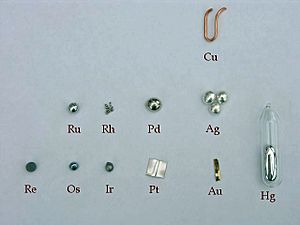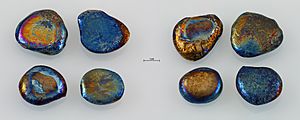Element collecting facts for kids


Element collecting is a fun hobby where people gather samples of the different chemical elements. These are the basic building blocks of everything around us. Many collectors enjoy finding interesting ways elements are used every day. Others like to learn about how elements behave. Some even do simple amateur chemistry experiments. Famous collectors like Theodore Gray have helped make this hobby more popular.
Contents
How to Get Elements
There are different ways to collect elements. Some collectors want very pure samples of each element. Others prefer to find elements in everyday items. For example, you might find copper in a penny or aluminum in a soda can.
Finding Elements at Home
You can even make some elements yourself! For instance, you can easily get hydrogen gas by using electricity to split water. This process is called electrolysis.
Collecting Element-Related Items
Besides pure elements, some collectors also gather items connected to them. This could be manufactured goods that contain the element. You might also find rocks or minerals that have the element inside them. Some companies even sell special coins made from pure elements. You can also find density cubes made from pure elements on auction sites like eBay.
Buying Elements for Your Collection
It can be hard to buy elements from big chemical companies. Luckily, there are now special stores online that sell elements to the public. They offer single samples or even full sets of elements. Many also sell elements on auction sites such as eBay.
Challenges in Collecting Elements
Collecting elements can be tricky because of their different properties.
Dangerous Elements
Some elements are dangerous. For example, mercury, thallium, and arsenic are toxic. This means they can be harmful if you touch or swallow them. Their sale is often restricted for safety.
Rare and Expensive Elements
Other elements are very rare. This makes them hard to find and quite expensive. Examples include scandium, lutetium, and thulium.
Reactive Elements
Some elements react very strongly with other things. Caesium and fluorine are examples of highly reactive elements. They are difficult to ship safely. Gallium can also react quickly with aluminum, which is used in things like aircraft.
Radioactive Elements
Then there are radioactive elements. These elements give off energy and can be dangerous. Elements like radon and astatine have very short half-lives. This means they decay quickly, making them almost impossible to collect.
Most collectors focus on stable elements. These are elements from hydrogen up to bismuth. The only exceptions are technetium and promethium, which are radioactive. However, some collectors do get very long-lived radioactive elements like thorium and uranium. You might also find small amounts of other radioactive elements. For example, radium can be found in old glow-in-the-dark paints. Americium is sometimes found in old smoke detectors.
See also
 In Spanish: Colección de elementos de la tabla periódica para niños
In Spanish: Colección de elementos de la tabla periódica para niños


